Tea pot, Mod. 2025
Christopher Dresser
Transcription
Narrator:
Imagine that a teapot can tell stories about the Industrial Revolution, Japanese craft traditions, and how one man changed the history of design.
Widar Halén, a senior researcher at the National Museum, explains:
Widar Halén:
This simple, yet fabulous, teapot was designed by Christopher Dresser in 1877. This was the same year that he returned home from an extended period of travelling, including five months in Japan, where he had been invited by the emperor himself to advise on how to develop Japan’s industries. So he had seen many factories, many workshops and gained many sources of inspiration.
And he saw how Japanese design was very simplified. Simplicity of form was something that the Japanese had developed to a sublime level, and Dresser took this to heart. And we see this here. The shape is actually one that is familiar from Japanese teapots, in that it’s slightly conical and the lid is completely flat. Flat lids were very common in Japan, while in Europe, lids were usually rounded, or had a flower or some other crazy detail on top.
Many teapots were difficult to hold, because there were so many ornaments, even on the handle. Victorian style was very ornamental and flamboyant, but here Dresser pares the teapot down to its bare essentials. This accorded with his belief that designs should be uncomplicated and functional, allowing them to be mass-produced and hence accessible to the general public.
Narrator:
Christopher Dresser took inspiration from Japan, exploited innovative techniques from the Industrial Revolution, and designed all kinds of things for home interiors, from soup bowls and glass vases to wallpaper and furniture – his products were produced by around 70 different factories. Dresser is often referred to as the world’s first industrial designer.